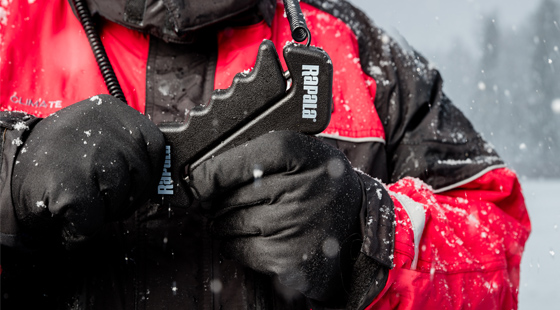
Safe ice and great fishing are just around the corner in much of the Ice Belt.
“Everyone should be pumped up this ice season,” Hawthorne says. “It’s looking like we’re going to have a great ice-fishing year. Once your ice is safe, you should have no trouble getting out there and catching some panfish.”
Follow These Tips to Ensure Your Safety:
Don’t step onto early-season ice without an ice chisel, such as Rapala’s two-piece 62-inch Chisel. When venturing out, thrust it into the ice ahead of your every step. If the ice cracks, or the chisel breaks through, turn back, it’s not safe there.
Wear Rapala Ice Safety Spikes around your neck. Spikes make it much easier to get enough grip and leverage to pull yourself up and out if you fall through the ice.
Leave most of your gear on shore when you first walk on the ice. This cuts down on weight and allows you move quietly. Pulling your sled creates noise that could prevent you from hearing warning signs.
Don’t step on the ice for the first time in the dark. Darkness can conceal dangerous cracks and soft spots. Instead of embarking before daybreak to fish an early-morning low-light bite, set out for the first time in full daylight.
Mark a safe route to your fishing spot – physically, and via a GPS track – that you can follow back safely to shore after fishing.
Wearing a personal flotation device (PFD). Carrying a throwable flotation device is not sufficient.
Bring a rope and a friend. One of you should walk a significant distance behind the other and carry a 100-foot rope. On both ends of the rope, tie a loop (but not a slip knot – preferably a bowline knot) large enough for a person to slip over his shoulders and under his armpits. A person can pull with more power with the rope around their body than just pulling with their arms. The person in the water should slip into the loop, if possible. Cold hands and shock from cold water can make it harder to hold onto a rope; should the person become weak, or pass out, a rope under their armpits can help a rescuer pull them out regardless.
Distribute your weight. If the ice does begin to crack, quickly get down on your hands and knees – or even lay down on the ice – to distribute your weight. Then slowly crawl back in the direction you’ve just come.
Share your travel plan. Set, stick to, and share with a spouse, significant other, friend or family member a travel plan – where you will be fishing, where you will park, and when you will get off the ice – and immediately call them to report your return to safe ground. Request that they come looking for you – or contact the authorities – if you do not call close to the appointed time. Use the same person every trip and never forget to call. You don’t want your person to think you forgot to call and assume that you are safe. That person could be your last chance at rescue.